Page 2395 of 3061
PB-2
< SERVICE INFORMATION >
PREPARATION
SERVICE INFORMATION
PREPARATION
Commercial Service ToolINFOID:0000000003532754
The actual shapes of Kent-Moore tools may differ from those of special service tools illustrated here.
Tool number
(Kent-Moore No.)
Tool nameDescription
—
(J-21177-A)
Brake drum clearance gaugeMeasuring rear rotor drum to parking
brake shoe clearance
Power toolLoosening bolts and nuts
WFIA0167E
PBIC0190E
Page 2396 of 3061
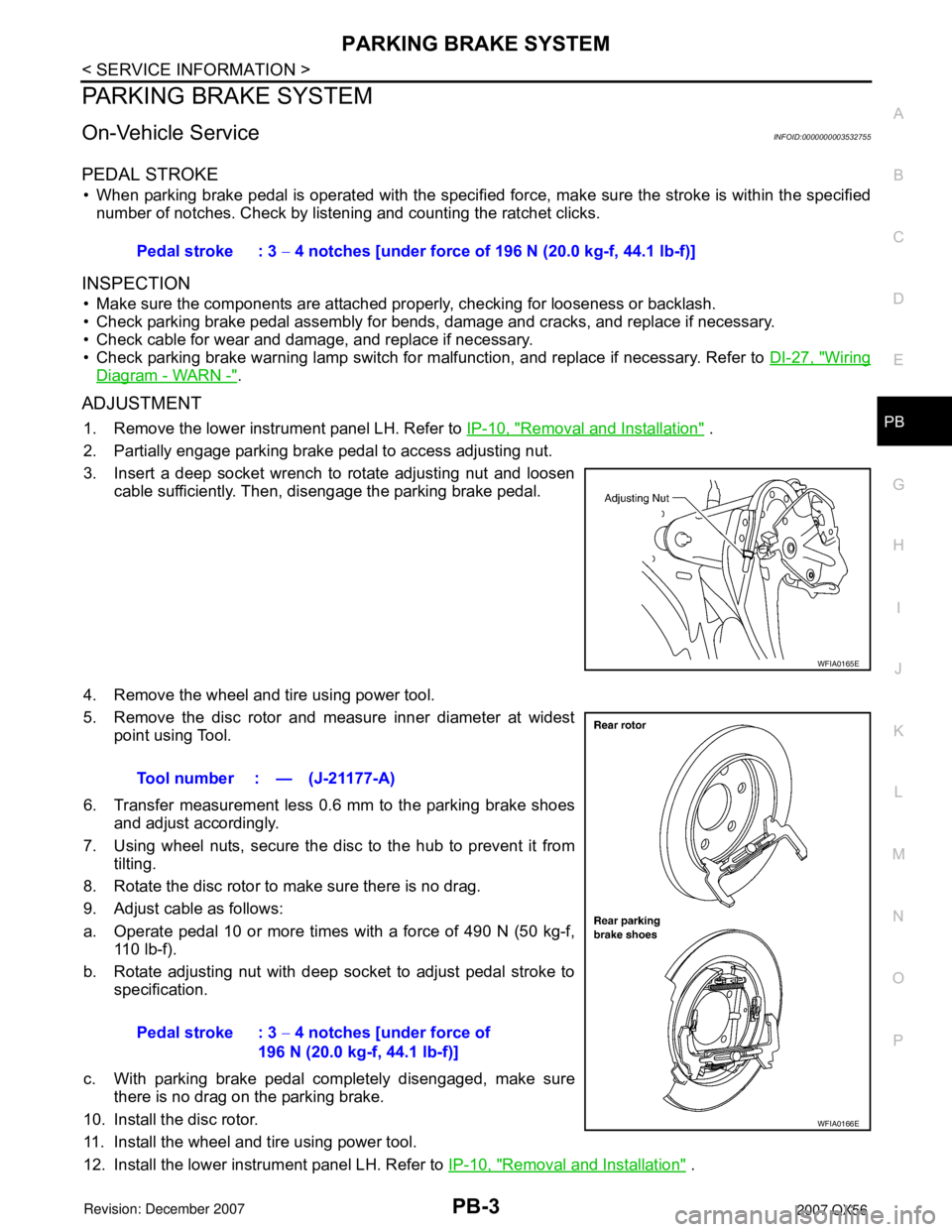
PARKING BRAKE SYSTEM
PB-3
< SERVICE INFORMATION >
C
D
E
G
H
I
J
K
L
MA
B
PB
N
O
P
PARKING BRAKE SYSTEM
On-Vehicle ServiceINFOID:0000000003532755
PEDAL STROKE
• When parking brake pedal is operated with the specified force, make sure the stroke is within the specified
number of notches. Check by listening and counting the ratchet clicks.
INSPECTION
• Make sure the components are attached properly, checking for looseness or backlash.
• Check parking brake pedal assembly for bends, damage and cracks, and replace if necessary.
• Check cable for wear and damage, and replace if necessary.
• Check parking brake warning lamp switch for malfunction, and replace if necessary. Refer to DI-27, "
Wiring
Diagram - WARN -".
ADJUSTMENT
1. Remove the lower instrument panel LH. Refer to IP-10, "Removal and Installation" .
2. Partially engage parking brake pedal to access adjusting nut.
3. Insert a deep socket wrench to rotate adjusting nut and loosen
cable sufficiently. Then, disengage the parking brake pedal.
4. Remove the wheel and tire using power tool.
5. Remove the disc rotor and measure inner diameter at widest
point using Tool.
6. Transfer measurement less 0.6 mm to the parking brake shoes
and adjust accordingly.
7. Using wheel nuts, secure the disc to the hub to prevent it from
tilting.
8. Rotate the disc rotor to make sure there is no drag.
9. Adjust cable as follows:
a. Operate pedal 10 or more times with a force of 490 N (50 kg-f,
110 lb-f).
b. Rotate adjusting nut with deep socket to adjust pedal stroke to
specification.
c. With parking brake pedal completely disengaged, make sure
there is no drag on the parking brake.
10. Install the disc rotor.
11. Install the wheel and tire using power tool.
12. Install the lower instrument panel LH. Refer to IP-10, "
Removal and Installation" . Pedal stroke : 3 − 4 notches [under force of 196 N (20.0 kg-f, 44.1 lb-f)]
WFIA0165E
Tool number : — (J-21177-A)
Pedal stroke : 3 − 4 notches [under force of
196 N (20.0 kg-f, 44.1 lb-f)]
WFIA0166E
Page 2397 of 3061
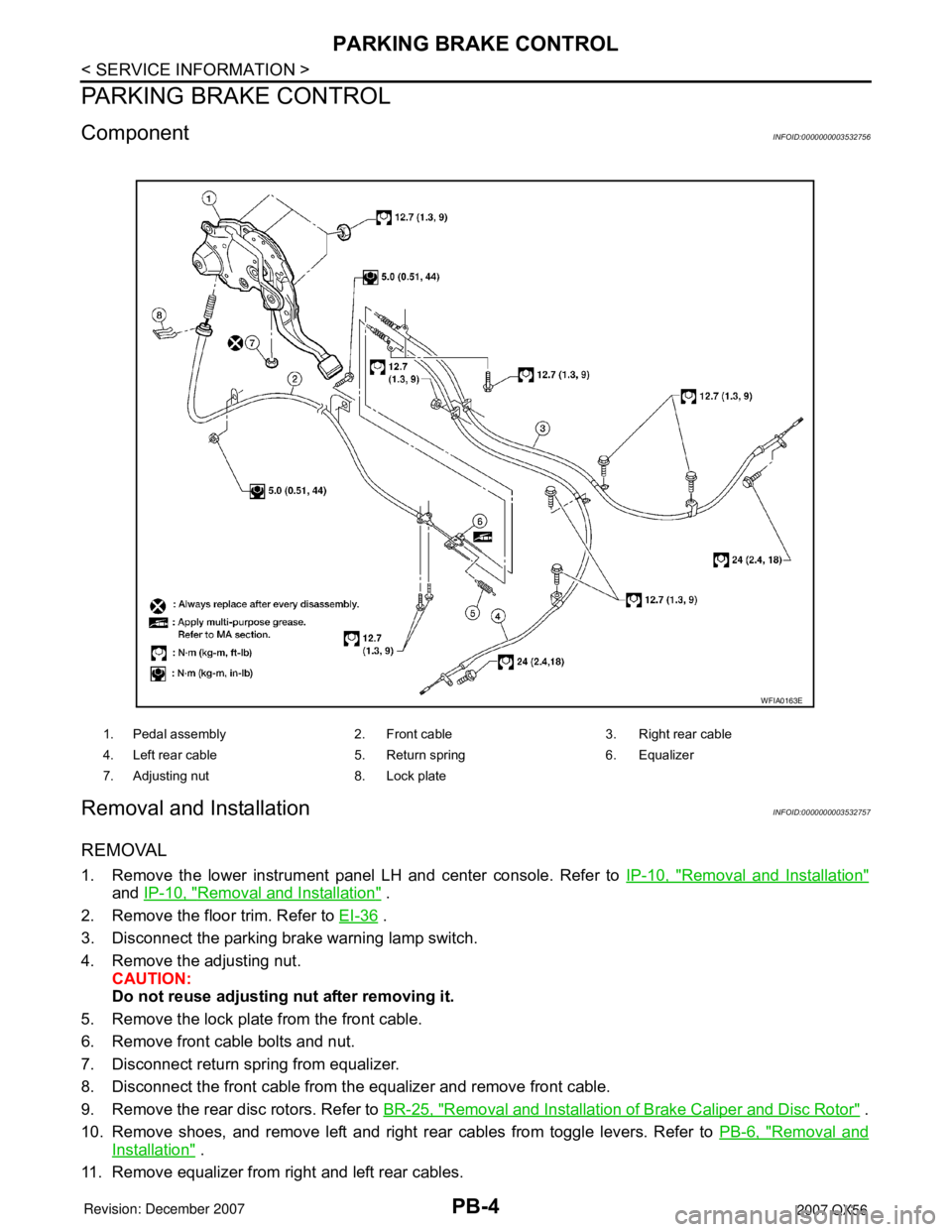
PB-4
< SERVICE INFORMATION >
PARKING BRAKE CONTROL
PARKING BRAKE CONTROL
ComponentINFOID:0000000003532756
Removal and InstallationINFOID:0000000003532757
REMOVAL
1. Remove the lower instrument panel LH and center console. Refer to IP-10, "Removal and Installation"
and IP-10, "Removal and Installation" .
2. Remove the floor trim. Refer to EI-36
.
3. Disconnect the parking brake warning lamp switch.
4. Remove the adjusting nut.
CAUTION:
Do not reuse adjusting nut after removing it.
5. Remove the lock plate from the front cable.
6. Remove front cable bolts and nut.
7. Disconnect return spring from equalizer.
8. Disconnect the front cable from the equalizer and remove front cable.
9. Remove the rear disc rotors. Refer to BR-25, "
Removal and Installation of Brake Caliper and Disc Rotor" .
10. Remove shoes, and remove left and right rear cables from toggle levers. Refer to PB-6, "
Removal and
Installation" .
11. Remove equalizer from right and left rear cables.
1. Pedal assembly 2. Front cable 3. Right rear cable
4. Left rear cable 5. Return spring 6. Equalizer
7. Adjusting nut 8. Lock plate
WFIA0163E
Page 2399 of 3061
PB-6
< SERVICE INFORMATION >
PARKING BRAKE SHOE
PARKING BRAKE SHOE
Removal and InstallationINFOID:0000000003532758
COMPONENTS
REMOVAL
WARNING:
Clean the brakes with a vacuum dust collector to minimize the hazard of airborne particles or other
materials.
NOTE:
Remove the disc rotor only with the parking brake pedal completely disengaged.
1. Remove wheel hub and bearing assembly. Refer to FA X - 5 , "
Removal and Installation" .
• Disconnect the wheel sensor at the harness connector. It is not necessary to remove the wheel sensor
from the wheel hub and bearing assembly.
2. Remove the return springs.
3. Remove the adjuster.
4. Remove the retainers, anti-rattle pins and shoes.
5. Disconnect the rear cable from the toggle lever.
6. Remove the back plate.
INSPECTION AFTER REMOVAL
Lining Thickness Inspection
1. Back plate 2. Shoes 3. Toggle lever
4. Return springs 5. Retainers 6. Adjuster
7. Anti-rattle pins
WFIA0164E
Page 2400 of 3061
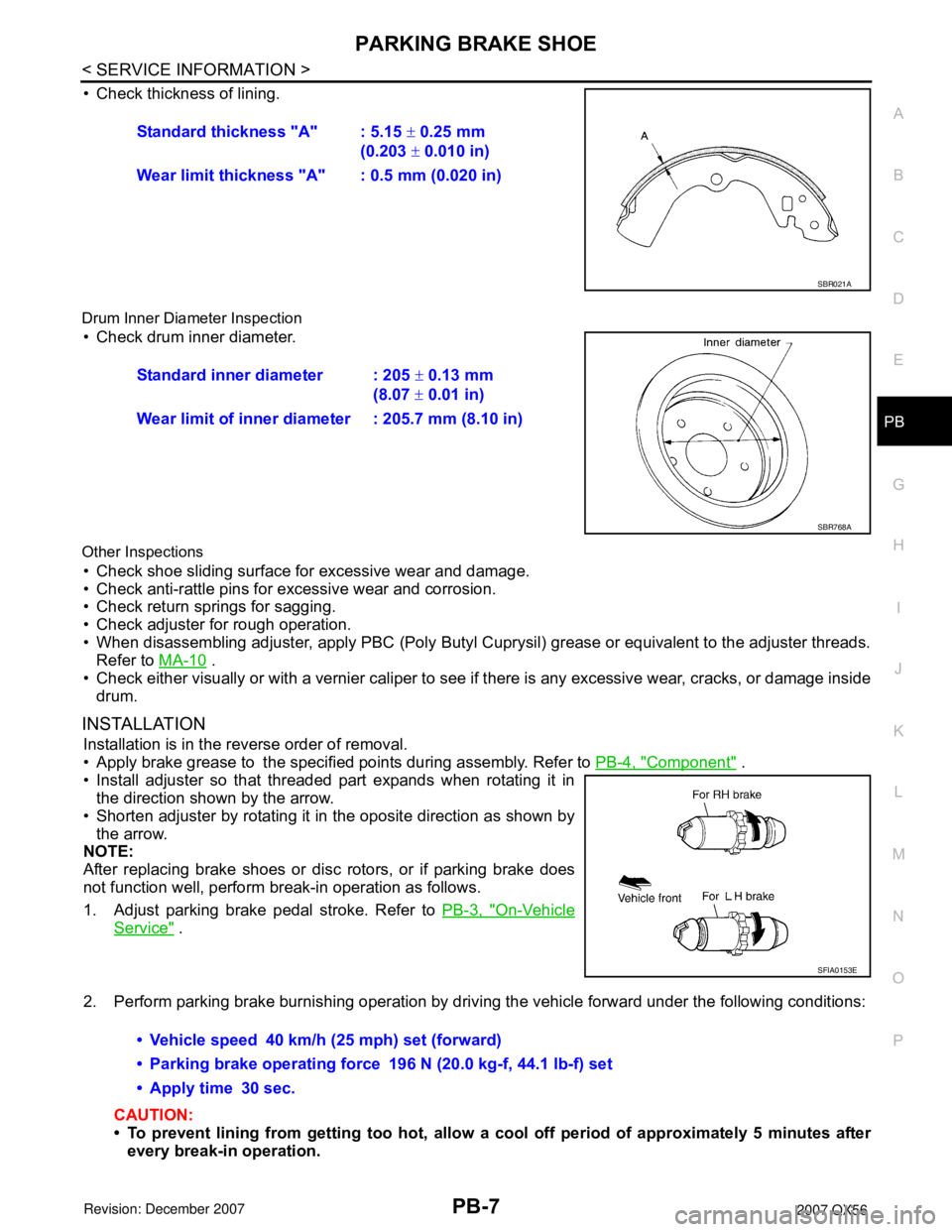
PARKING BRAKE SHOE
PB-7
< SERVICE INFORMATION >
C
D
E
G
H
I
J
K
L
MA
B
PB
N
O
P
• Check thickness of lining.
Drum Inner Diameter Inspection
• Check drum inner diameter.
Other Inspections
• Check shoe sliding surface for excessive wear and damage.
• Check anti-rattle pins for excessive wear and corrosion.
• Check return springs for sagging.
• Check adjuster for rough operation.
• When disassembling adjuster, apply PBC (Poly Butyl Cuprysil) grease or equivalent to the adjuster threads.
Refer to MA-10
.
• Check either visually or with a vernier caliper to see if there is any excessive wear, cracks, or damage inside
drum.
INSTALLATION
Installation is in the reverse order of removal.
• Apply brake grease to the specified points during assembly. Refer to PB-4, "
Component" .
• Install adjuster so that threaded part expands when rotating it in
the direction shown by the arrow.
• Shorten adjuster by rotating it in the oposite direction as shown by
the arrow.
NOTE:
After replacing brake shoes or disc rotors, or if parking brake does
not function well, perform break-in operation as follows.
1. Adjust parking brake pedal stroke. Refer to PB-3, "
On-Vehicle
Service" .
2. Perform parking brake burnishing operation by driving the vehicle forward under the following conditions:
CAUTION:
• To prevent lining from getting too hot, allow a cool off period of approximately 5 minutes after
every break-in operation.Standard thickness "A" : 5.15 ± 0.25 mm
(0.203 ± 0.010 in)
Wear limit thickness "A" : 0.5 mm (0.020 in)
SBR021A
Standard inner diameter : 205 ± 0.13 mm
(8.07 ± 0.01 in)
Wear limit of inner diameter : 205.7 mm (8.10 in)
SBR768A
SFIA0153E
• Vehicle speed 40 km/h (25 mph) set (forward)
• Parking brake operating force 196 N (20.0 kg-f, 44.1 lb-f) set
• Apply time 30 sec.
Page 2523 of 3061
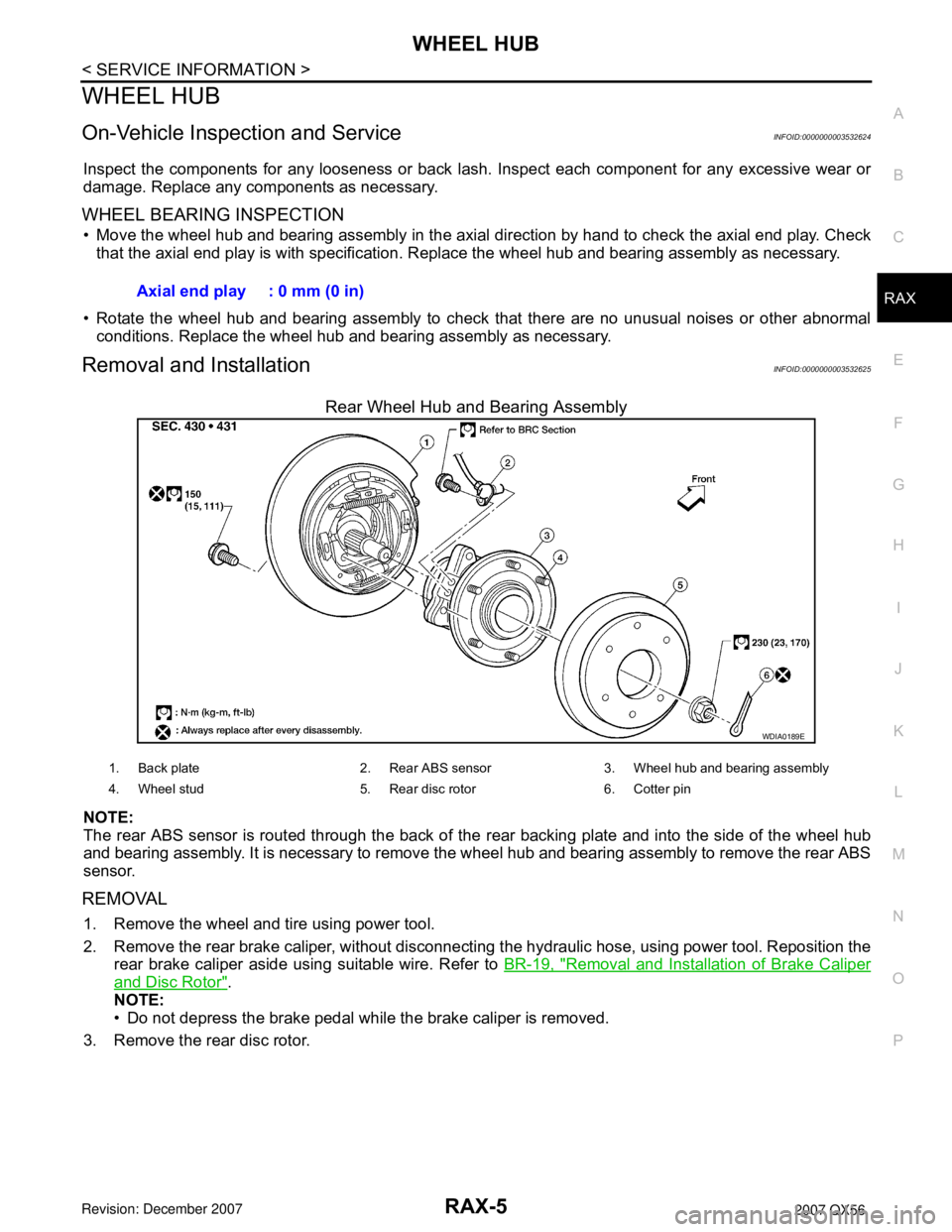
WHEEL HUB
RAX-5
< SERVICE INFORMATION >
C
E
F
G
H
I
J
K
L
MA
B
RAX
N
O
P
WHEEL HUB
On-Vehicle Inspection and ServiceINFOID:0000000003532624
Inspect the components for any looseness or back lash. Inspect each component for any excessive wear or
damage. Replace any components as necessary.
WHEEL BEARING INSPECTION
• Move the wheel hub and bearing assembly in the axial direction by hand to check the axial end play. Check
that the axial end play is with specification. Replace the wheel hub and bearing assembly as necessary.
• Rotate the wheel hub and bearing assembly to check that there are no unusual noises or other abnormal
conditions. Replace the wheel hub and bearing assembly as necessary.
Removal and InstallationINFOID:0000000003532625
Rear Wheel Hub and Bearing Assembly
NOTE:
The rear ABS sensor is routed through the back of the rear backing plate and into the side of the wheel hub
and bearing assembly. It is necessary to remove the wheel hub and bearing assembly to remove the rear ABS
sensor.
REMOVAL
1. Remove the wheel and tire using power tool.
2. Remove the rear brake caliper, without disconnecting the hydraulic hose, using power tool. Reposition the
rear brake caliper aside using suitable wire. Refer to BR-19, "
Removal and Installation of Brake Caliper
and Disc Rotor".
NOTE:
• Do not depress the brake pedal while the brake caliper is removed.
3. Remove the rear disc rotor.Axial end play : 0 mm (0 in)
WDIA0189E
1. Back plate 2. Rear ABS sensor 3. Wheel hub and bearing assembly
4. Wheel stud 5. Rear disc rotor 6. Cotter pin
Page 2617 of 3061
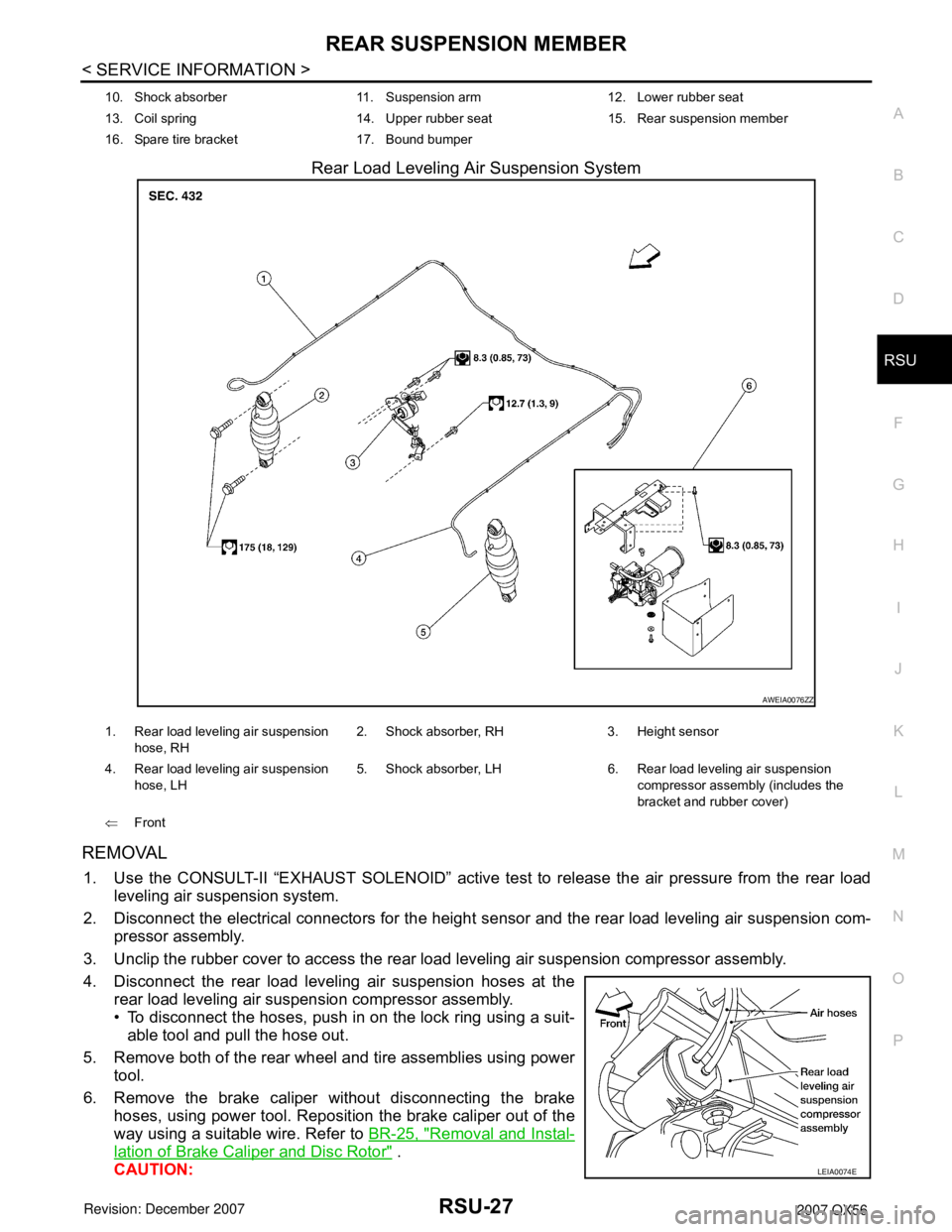
REAR SUSPENSION MEMBER
RSU-27
< SERVICE INFORMATION >
C
D
F
G
H
I
J
K
L
MA
B
RSU
N
O
P
Rear Load Leveling Air Suspension System
REMOVAL
1. Use the CONSULT-II “EXHAUST SOLENOID” active test to release the air pressure from the rear load
leveling air suspension system.
2. Disconnect the electrical connectors for the height sensor and the rear load leveling air suspension com-
pressor assembly.
3. Unclip the rubber cover to access the rear load leveling air suspension compressor assembly.
4. Disconnect the rear load leveling air suspension hoses at the
rear load leveling air suspension compressor assembly.
• To disconnect the hoses, push in on the lock ring using a suit-
able tool and pull the hose out.
5. Remove both of the rear wheel and tire assemblies using power
tool.
6. Remove the brake caliper without disconnecting the brake
hoses, using power tool. Reposition the brake caliper out of the
way using a suitable wire. Refer to BR-25, "
Removal and Instal-
lation of Brake Caliper and Disc Rotor" .
CAUTION:
10. Shock absorber 11. Suspension arm 12. Lower rubber seat
13. Coil spring 14. Upper rubber seat 15. Rear suspension member
16. Spare tire bracket 17. Bound bumper
AWEIA0076ZZ
1. Rear load leveling air suspension
hose, RH2. Shock absorber, RH 3. Height sensor
4. Rear load leveling air suspension
hose, LH5. Shock absorber, LH 6. Rear load leveling air suspension
compressor assembly (includes the
bracket and rubber cover)
⇐Front
LEIA0074E